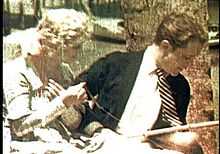The Gulf Between (1917 film)
| The Gulf Between | |
|---|---|
 A surviving frame of the film from a subtractive printing test, approximating the appearance of the original additive two-color projection | |
| Directed by | Wray Bartlett Physioc |
| Written by |
Anthony Paul Kelly J. Parker Read Jr. |
| Starring |
Grace Darmond Niles Welch |
| Cinematography | Carl Gregory |
| Distributed by | Technicolor Motion Picture Corporation[1] |
Release dates |
|
Running time | ≤ 58 minutes at 32 frame/sec. (seven reels[1])[2] |
| Country | United States |
| Language |
Silent English intertitles |
The Gulf Between (1917) was the first motion picture made in Technicolor, the fourth feature-length color movie,[3] and the first feature-length color movie produced in the United States. Today, the film is considered a lost film, with only very short fragments known to survive. These fragments are in the collections of the Margaret Herrick Library, George Eastman House and the Smithsonian National Museum of American History Photography Dept.[4]
The Gulf Between was directed by Wray Bartlett Physioc. The lead roles were played by Grace Darmond and Niles Welch.
Synopsis
The story is about a girl raised by a sea captain, and her rejection by the wealthy family of the young man she loves.
Cast
- Grace Darmond ... Marie
- Niles Welch ... Richard Farrell
- Herbert Fortier ... Robert Farrell
- Violet Axzelle ... Marie, as a child (as Violet Axzell)
- Charles Brandt ... Captain Flagg
- Joseph Dailey ... Cook
- George De Carlton ... Dutch
- Caroline Harris ... Mrs. Farrell
- Virginia Lee ... Millicent Dunston
- Louis Montjoy
- J. Noa ... Pete
Production
The Gulf Between was filmed on location in Jacksonville, Florida in 1917 by the Technicolor Motion Picture Corporation, using its two-color "System 1", in which, by means of a prism beam splitter, two frames of a single strip of black-and-white film were photographed simultaneously, one behind a red filter and the other behind a green filter.
Release
After private trade showings in Boston on September 13, 1917,[5] and at Aeolian Hall in New York City on September 21, 1917,[6] it was released on February 25, 1918 to play one-week engagements on a tour of a few major Eastern cities, accompanied by the special two-aperture, two-lens, two-filter projector required to exhibit it. Because of the technical problems in keeping the red and green images aligned by prism during projection, it was the only motion picture made in Technicolor's System 1. Technicolor abandoned the additive color process of System 1, and began work on subtractive color processes that did not require a special projector.
Critical reception
Photoplay magazine complained that all colors were reduced into terms of reds and greens, and that "the story is dull, trite, and drawn out interminably."[7]
References
- ↑ 1.0 1.1 "The Gulf Between - 1918". Buffalo International Film Festival. Retrieved March 28, 2013.
- ↑ System 1 was photographed and projected at 32 frames per second, twice the normal speed. Thus, seven reels of a Technicolor film were equal to 3.5 reels of a normal film.
- ↑ The first three color features were With Our King and Queen Through India (also known as The Durbar at Delhi, 1912) and the dramas The World, the Flesh and the Devil (1914), and Little Lord Fauntleroy (1914), all filmed in the Kinemacolor process.
- ↑ "The Gulf Between". Deutsche Kinemathek. Retrieved March 28, 2013.
- ↑ "Photoplay in Colors of Nature Exhibited", Christian Science Monitor, September 14, 1917, p. 4.
- ↑ SilentEra entry
- ↑ "The Shadow Stage", Photoplay, December 1917, p. 118.
External links
- The Gulf Between at the Internet Movie Database
- The Gulf Between at SilentEra
- The Gulf Between at Widescreen Museum with copy of film frame